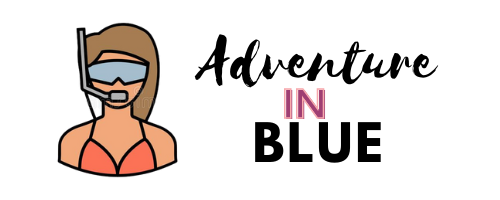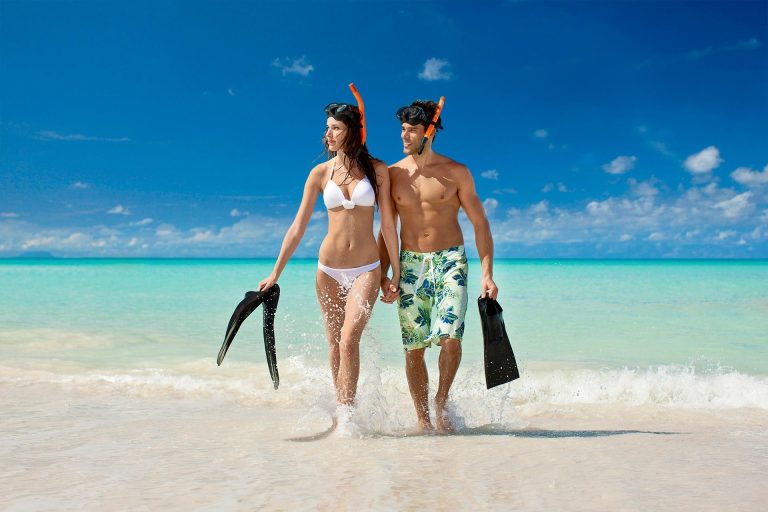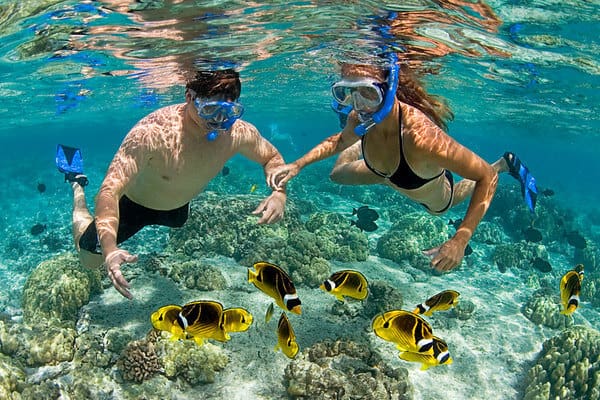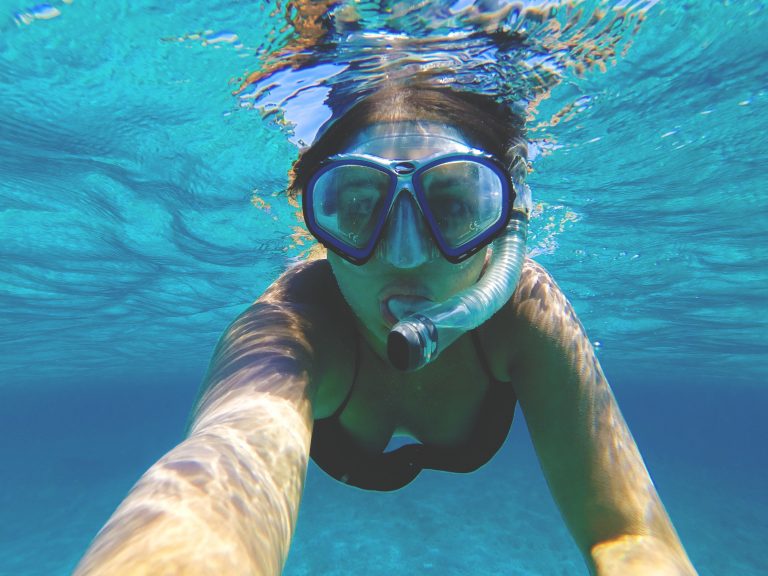Can I Snorkel If I Can’t Swim?
Even if you aren’t a strong swimmer, you may still enjoy the benefits of scuba diving and snorkeling by following a few simple safety guidelines.
Can I Snorkel If I Can’t Swim? 7 Ways To Enjoy The Water Safely & Smartly
Snorkeling is a simple and exciting way to see underwater life. You don’t need a lot of gear or training to start. Just a mask, snorkel, and fins, and you’re ready to go. It’s easy for everyone to try, even if you’re not a swimmer.
So, to all the aspiring snorkelers worried about their swimming skills, worry no more. With the proper precautions and courage, the ocean’s wonders are well within your reach. We’ll give you tips to make snorkeling fun and safe for everyone.
Keep an eye out for our article to learn more about enjoying snorkeling without any worries. Let’s dive into some snorkeling safety tips to help you confidently embark on this aquatic journey.
Can I Snorkel if I Can’t Swim? A Quick Answer
Yes, you can snorkel even if you can’t swim; everyone can enjoy snorkeling. It’s mostly just floating on the water and looking at the fish and plants below. You don’t have to be a swimmer to try it. Before you start, there are a few simple things to learn to ensure you have a great time in the water.
How Can I Snorkel If I Can’t Swim?
Snorkeling is celebrated for its safety, making it a fantastic way to explore underwater wonders with minimal risk. In fact, it’s considered one of the safest water activities around.
To put it into perspective, research from Australia highlights its safety, noting a very low incidence of snorkeling-related fatalities—only 11 annually amidst millions of dives, especially in iconic spots like the Great Barrier Reef. However, like any adventure, being aware of your surroundings and taking appropriate safety measures is crucial.
While snorkeling’s safety record is impressive, it’s essential for everyone, especially those new to the sport or those who aren’t strong swimmers, to approach it with caution. Ensuring you’re in good health and fit for snorkeling is also crucial to preparing for a safe and enjoyable experience.
1. Snorkel Where You Can Stand

Snorkeling in shallow waters where you can comfortably stand is a smart choice for those who need more confidence in their swimming abilities. It provides a safety net, allowing you to quickly stand and regain your bearings if required. This approach boosts your confidence and keeps you safe as you enjoy the underwater spectacle.
Even in shallow waters, places like Bonaire offer stunning snorkeling experiences just a few feet from shore, where you can encounter tropical fish, crabs, and rays. While the most breathtaking marine life awaits in deeper waters, starting in the shallows is an excellent way to gradually improve your swimming skills for future adventures.
When snorkeling near shore, it’s crucial to be mindful of the sea bottom. Sandy areas require minimal foot protection, making snorkel fins optional unless you’re venturing further out. However, areas with coral or rocky bottoms demand caution and appropriate footwear, like water shoes, to protect against cuts and support safe exploration.
Remember, coral is delicate and should never be touched or stepped on to avoid damage to the coral and yourself. For those navigating rocky or coral-rich bottoms, water shoes [like the ALEADER Mesh Slip-On Water Shoes (For Men) and (For Women] are highly recommended to ensure safety and comfort during your snorkeling adventure.
2. Use a Snorkel Vest or Life Jacket
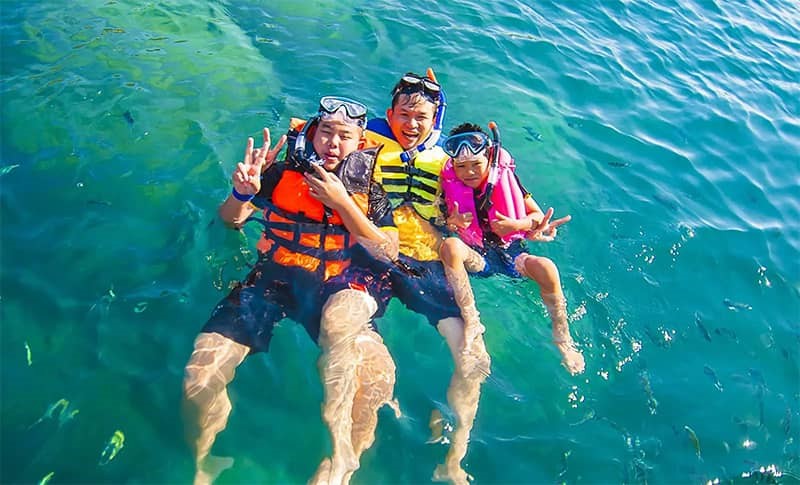
Incorporating a flotation device like a snorkel vest or life jacket for those new to swimming can significantly enhance their safety and enjoyment while snorkeling. These aids ensure they stay afloat and feel secure as they explore underwater wonders.
Snorkel vests are lighter and offer more freedom of movement than life jackets, making them ideal for those who need just a bit of assistance with buoyancy. On the other hand, life jackets provide more comprehensive support for non-swimmers, ensuring maximum safety in the water.
Both flotation devices are travel-friendly, with many models being easily deflatable for packing and inflatable for use. The Seaview Palawan Snorkel Vest is a fantastic option for snorkeling, offering comfort and just the right amount of lift, and is available on Amazon.
For those seeking the added security of a life jacket, the Hardcore Water Sports Life Jacket is a reliable choice, widely available at outdoor retailers and on Amazon. When selecting a flotation device, choosing the correct size that matches your body weight and size is crucial to ensure the best fit and effectiveness.
3. Use a Dry-Top Snorkel and Proper Mask
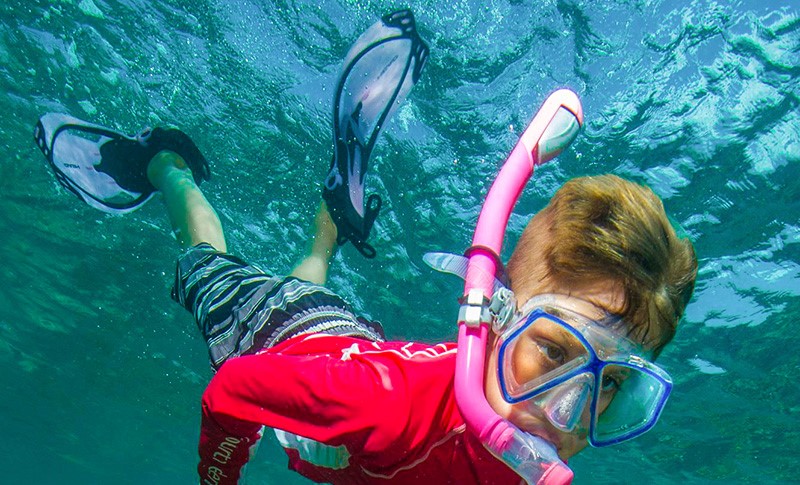
Snorkeling gear has come a long way from the bare open tubes of the past. Today’s snorkels are engineered for ease and safety, making underwater exploration accessible to everyone, including beginners and inexperienced swimmers.
Modern snorkels boast innovative features such as the dry-top valve, which automatically seals to prevent water entry when submerged, and the purge valve, located at the bottom, enabling users to clear out any water with a simple exhale. Additionally, a reservoir below the mouthpiece catches any drips, ensuring a dry breathing experience.

The Oceanic Ultra-Dry 2 snorkel is a stellar choice for a top-notch snorkeling experience. It combines a dry-top valve, purge valve, and reservoir, providing a comfortable and user-friendly snorkeling adventure.
When it comes to the best snorkel masks, the fit is king. A well-fitting mask prevents leaks and discomfort, making your snorkeling session enjoyable rather than frustrating.
For beginners, the Cressi F1 Frameless snorkel mask is an excellent start. Its single-lens design and soft silicone skirt offer a wide field of vision and a comfortable fit at an affordable price. The SCUBAPRO Solo and Atomic Venom Frameless masks offer advanced features like reduced weight, enhanced clarity, and superior comfort with easy adjustment mechanisms for those ready to level up.
4. Test Your Equipment Before You Go

Before diving into the underwater spectacle of snorkeling, getting acquainted with your gear is crucial for a safe and enjoyable experience. Here’s a quick guide on how to test your snorkel and mask effectively:
- Fit Your Mask Perfectly: Start by placing the mask on your face and adjusting the straps for a snug yet comfortable fit. To ensure there are no leaks, lightly inhale through your nose. The mask should stay in place without letting air escape.
- Secure Your Snorkel: Attach your snorkel to the mask strap and gently bite down on the mouthpiece, ensuring your lips seal around it. Breathe through the snorkel to check for any air or water leaks.
- Chest-Deep Water Test: Walk into shallow water until it’s chest-deep, then lower your face. Listen for the dry-top valve’s click, signaling it’s closed to block water entry. Breathe through the snorkel to ensure easy breathing without water intrusion.
- Clearing the Snorkel: If water enters your snorkel, expel it using the purge valve by exhaling sharply. This action forces water out through the valve. A slight head tilt may help drain any residual water.
- Practice Makes Perfect: Repeat these steps until you’re comfortable with the gear. Practice moving and swimming in water to test the equipment under various conditions. Make adjustments as needed for comfort or performance.
By familiarizing yourself with your snorkel and mask before venturing further, you’re setting the stage for a safer and more enjoyable snorkeling adventure. Ready for more tips? Dive into our comprehensive guide on maintaining your snorkel gear for lasting performance and safety.
5. Always Stick Close with a Buddy Who Can Swim
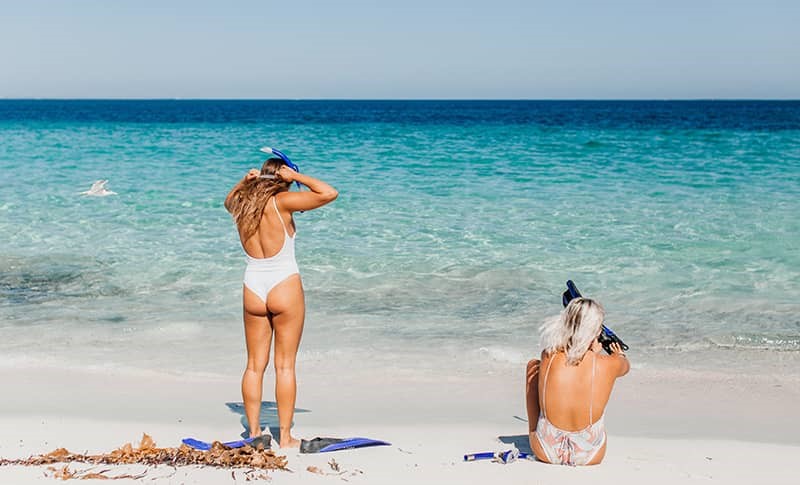
Snorkeling is an adventure best shared, making the buddy system an essential part of the experience. Whether you’re just starting or are a seasoned explorer of the seas, having a snorkeling partner ensures safety and enjoyment.
Your buddy acts as your support system in the water, ready to assist during any unexpected situations like fatigue, muscle cramps, or equipment issues. They’re not just there for safety; they’re also your partner in discovery, pointing out mesmerizing marine life and underwater scenes you might otherwise overlook.
For weak swimmers, pairing up with someone confident in the water is crucial. This ensures you have reliable assistance close at hand. Additionally, wearing a flotation device adds an extra layer of safety, helping you stay buoyant and enjoy your snorkeling adventure without worry.
Choosing calm, shallow waters where you can see the sea bed further enhances your safety, making your snorkeling experience more relaxed and enjoyable.
Snorkeling with a buddy isn’t just about safety—it’s about sharing the wonder and excitement of the underwater world. Together, you can explore, experience, and create memories that will last a lifetime. So, remember, two is always better than one when it comes to snorkeling!
6. Only Snorkel in Calm Waters

Enjoying snorkeling starts with choosing the right conditions, especially if you need to be a stronger swimmer. Opting for clear, calm waters is crucial for a safe and enjoyable underwater adventure, steering clear of areas with rough seas, deep waters, or strong currents that could pose risks.
Before setting out, a little research can help ensure you pick a suitable spot. Read online reviews, snorkeling guides, or blogs to gather insights. Feel free to seek advice from local experts like lifeguards or hotel staff, who can offer up-to-date information on the best places to snorkel and any potential hazards.
Another quick tip to assess water safety is to observe the beach flags, which use a color-coded system to indicate conditions:
- Green Flag: You’re good to go! The calm water is perfect for beginners or those who prefer a gentle snorkeling experience.
- Yellow Flag: Caution is critical. Expect some waves or currents. Wearing a flotation device and sticking with a buddy is wise.
- Red Flag: Warning – the water is rough with strong currents. It’s best avoided unless you’re an experienced swimmer and snorkeler.
- Purple Flag: This is a heads-up for marine life that could be harmful. Ensure you’re equipped with proper protection and knowledgeable about the area.
Choosing the right conditions and being aware of your surroundings can ensure a memorable and safe snorkeling experience.
7. Take a Snorkel Lesson or Beginners Tour
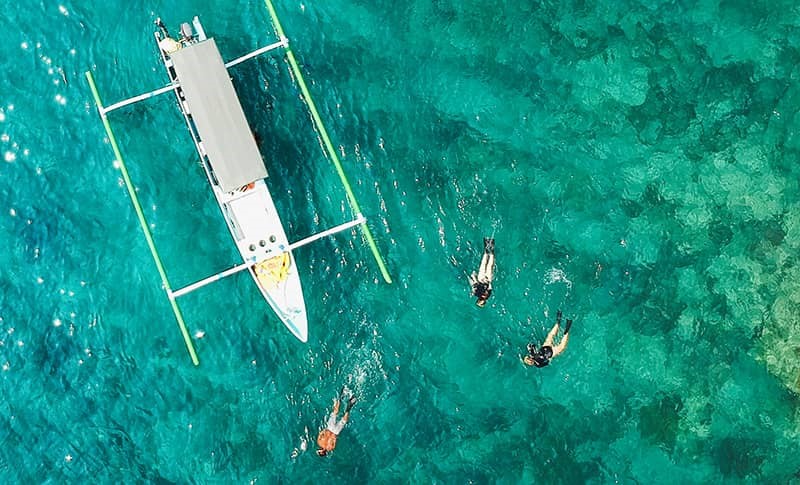
Diving into the world of snorkeling is an exciting adventure, opening a window to the vibrant life beneath the waves. If you’re eager to explore but swimming isn’t your strong suit, don’t worry! With the proper preparation and guidance, snorkeling can be accessible and enjoyable for everyone.
- Gear Up: Start by equipping yourself with a snorkel, mask, and fins. These tools will help you breathe easily, see the underwater beauty in high definition, and glide through the water gracefully. You can find these items available for purchase or rent at local shops or online. Remember to use a flotation device like a life jacket or snorkel vest to stay buoyant and safe.
- Choose the Right Class or Tour: To ease into snorkeling, consider joining a beginner-friendly class or tour. Look online or ask your hotel or travel agency for recommendations. Options vary widely, catering to different skill levels and budgets. Whether it’s an introductory snorkeling course on (Viator) that covers the fundamentals and safety or an excursion to prime snorkeling locales, you’ll find something that suits your needs. Always check reviews and ratings to ensure a quality experience.
- Learn from the Pros: By signing up for a class or tour, you gain access to professional guidance. Instructors and guides will teach you how to safely use your equipment, snorkel and fully appreciate the marine environment. Plus, you’ll connect with fellow snorkeling enthusiasts, adding a social dimension to your adventure.
- Communicate Your Needs: Be upfront about your swimming abilities and any concerns with your guide or instructor. This transparency allows them to tailor the experience to your comfort level, ensuring you receive any additional support required.
Snorkeling is more than just a sport; it’s a gateway to discovering the ocean’s wonders. With the right approach, even those less confident in the water can embrace this mesmerizing activity confidently.
Conclusion
Snorkeling offers a gateway to the ocean’s wonders without requiring expert swimming skills. The key is feeling at ease in the water to avoid panic. Choosing the right snorkeling spot is crucial—opt for shallow waters if you’re not confident in deep waters. Familiarize yourself with your equipment, inform your instructor of your swimming abilities, and always snorkel with a buddy for safety.
Even beginners can enjoy spectacular sights in shallow waters, like whale shark encounters. Besides its underwater allure, snorkeling benefits your health by strengthening the heart, toning your legs, enhancing joint mobility, and reducing stress through endorphin release. Don’t let being unable to swim deter you from the enriching experience snorkeling promises.
